Register here or use the QR code:
https://go.rutgers.edu/RUReadytoFarmEquipmentDemo

Rutgers Cooperative Extension
Seasonal updates and alerts on insects, diseases, and weeds impacting vegetable crops. New Jersey Commercial Vegetable Production Recommendations updates between annual publication issues are included.
Subscriptions are available via EMAIL and RSS.
Quick Links:
 NJ Commercial Vegetable Production Recommendations
NJ Commercial Vegetable Production Recommendations
 Rutgers Weather Forecasting - Meteorological Information important to commercial agriculture.
Rutgers Weather Forecasting - Meteorological Information important to commercial agriculture.
The U.S. Food and Drug Administration (FDA) invites the public to registerExternal Link Disclaimer for a webinar on the Standards for the Growing, Harvesting, Packing, and Holding of Produce for Human Consumption Relating to Agricultural Water (Agricultural Water Final Rule). The purpose of this webinar is to provide an overview of the final rule and answer pre-submitted and live questions.
Background
The final rule replaces certain pre-harvest agricultural water requirements for covered produce (other than sprouts) in the 2015 Produce Safety Rule with requirements for systems-based agricultural water assessments to determine and guide appropriate measures to minimize potential risks associated with pre-harvest agricultural water. Specifically, this rule:
The rule also finalizes the dates for compliance with the pre-harvest agricultural water requirements for non-sprout covered produce as follows:
Registration
The May 20 webinar is a virtual event. Registration is free and will be open through the day of the webinar. Persons interested in attending the public meeting must register at: FSMA Final Rule on Pre-Harvest Agricultural Water Webinar
If you have questions about the final rule that you wish to submit for possible discussion during the webinar, please note them during registration. All questions must be received by May 15, 2024, to be considered for discussion.
The weather this spring has been relatively wet with a few hot days sprinkled in between. Unfortunately, these weather patterns can cause problems in transplant production, especially when it comes time for watering. Hot days may require more than one watering, and cloudy days may require no water. In either case, growers need to anticipate their transplant water needs without over or under estimating watering. Of course, other factors include the growing media and the plant itself. Lets focus on media, for example, growers using a lighter soilless media, these will dry out much quicker than a heavier media and will require more daily watering (e.g., once in AM, afternoon, and evening). Growers using a heavier media may only have to water once a day, or early in the AM and maybe once more in the PM. Either type of media works fine as long as the weather doesn’t change and it fits the growers needs. Proper transplant watering is all about adjustment. If you have stuck to the same daily watering schedule this spring its very likely you have grossly over or under watered your transplants at some point. And, in all likelihood, grossly over or under watered trying to correct the situation. Uniformity is also key when it comes to proper transplant watering. If you find yourself spot watering out of schedule because some flats dry out quicker than others then most likely your uniformity is off. This is easily done when watering is done by hand with a wand. Poor uniformity can also be the result of transplant flats being set on uneven benches or uneven floors. Much like a field, low spots tend to collect the most water. All of this can lead to uneven transplant growth as well as disease and pest pressure, such as fungus gnat problems. If you are experiencing uneven transplant growth, then most likely your watering is uneven. For transplant growth to remain even, flats need to be watered each time to maximum water holding capacity, where each cell in the flat holds the maximum amount of water. An easy way to see this is to watch for water dripping out the bottom of the flat. As important, flats should also uniformly dry out. Below is an example of tomato transplants that have been pulled from the same flat. You can see the differences in plant height as well as root system formation as a result of uneven watering in a “heavy” soilless media. Cells that have remained on the wet side show poor growth and poor root system development because of a waterlogged cell; whereas cells that have been receiving the appropriate amount of water have much better growth and a nice root ball. The weight test. When was the last time you picked up a transplant tray? Picking up a transplant flat every once in a while will give you an idea of how well your watering schedule and uniformity is. Everyone has picked up a tray that has felt like it has the weight of a rock or the tray breaks apart because of the weight, or when you pick it up and it feels as light as a feather. Doing this is a good way to determine if your soilless media is “heavy” – holds more water than you think or if you have been overwatering on days you shouldn’t be or if you have not watered enough. Consistency is key when watering. Going from an extremely wet to an extremely dry transplant tray is not what you want for the transplant production season. You want consistent soil moisture as much as possible, thus proper transplant watering is all about the proper adjustments and knowing your media.
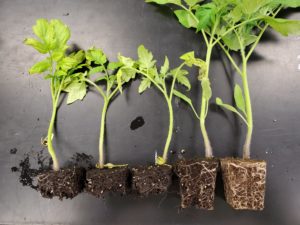
Differences in soil moisture across a single flat of tomato transplants.
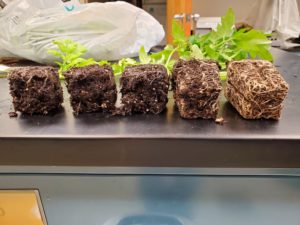
Roots of tomato transplants in a flat that has irregular soil moisture.
It is extremely important to know which pathogen is causing damping-off problems and which fungicide to properly apply. The key to controlling damping-off is being proactive instead of reactive. Always refer to the fungicide label for crop use, pathogens controlled, and application rates.
Damping-off is caused by a number of important vegetable pathogens and is very common at transplanting. Common pathogens that cause damping-off include Pythium, Phytophthora, Rhizoctonia and Fusarium spp.
Control of damping-off depends on a number of factors. First, is recognizing the conditions which may be leading to the problem (i.e., watering schedule/greenhouse growing conditions) and second, identifying the pathogen causing the problem. Reducing the chances for damping-off always begins with good sanitation practices prior to transplant production.
Although all four pathogens are associated with damping-off, the conditions which favor their development are very different. In general, Phytophthora and Pythium are more likely to cause damping-off in cool, wet or overwatered soils that aren’t allowed to dry out due to cloudy weather or cooler temperatures. Conversely, Rhizoctonia and Fusarium are more likely to cause damping-off under warmer, drier conditions especially if plug trays are kept on the dry side to help reduce transplant growth. [Read more…]
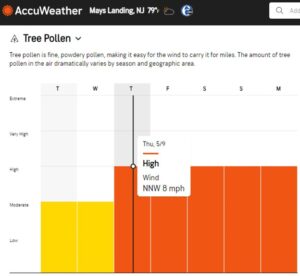
Accuweather Tree Pollen Forecast for Southern NJ
Though the CDC Heat Risk Forecast indicates minor risk today, and little to none for the rest of the week, NJ pollen forecasts indicate tree pollen counts will be high for the next several days. It doesn’t take much outdoor work to see, and feel, the amount of pollen in the air.

Pollen quickly accumulating on surfaces during this week’s tree shedding.
Working in these conditions can be uncomfortable with that combination of heat and pollen, and risky for those with respiratory health problems and/or allergies. Those KN-95 masks used for COVID-19 prevention can reduce the discomfort of working in high pollen and other dusty conditions, so keep a supply on hand for all your workers.
Fruit rots in strawberry can cause significant losses if not recognized early and properly controlled. The use of good cultural practices such as keeping fields weed-free, promoting good drainage and air movement, long crop rotations, and preventative fungicide applications are critically important for reducing the potential development of fruit rots in strawberry.
Pathogens such as anthracnose fruit rot (Collectotrichum spp.), gray mold (Botrytis cinera), and leather rot (Phytophthora cactorum) can become systemic problems in strawberry fields and can be difficult to manage over the lifetime of the planting. Importantly, fungicide resistance development in the pathogens that cause fruit rot in strawberry are widely documented; mostly in Botrytis.
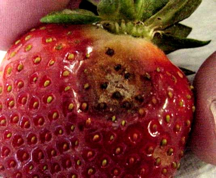
Anthracnose Fruit Rot of Strawberry
Anthracnose fruit rot can cause serious losses if not controlled. Symptoms of anthracnose include the development of circular, sunken lesions on infected fruit. Often pinkish/tan colored spore masses will develop in the center of lesions. Anthracnose in strawberry is caused by Colletotrichum spp. Spore production, germination and fruit infection are favored by warm, humid weather. The fungus can overwinter on infected plants, in plant debris or on weed hosts. Spores are dispersed by splashing water and can infect green and mature fruit. Control begins with protectant fungicides from flowering through harvest. Begin sprays no later than 10% bloom or prior to disease development and continue on a 7 to 10 day interval. Use the higher fungicide rate and shorter intervals when disease pressure is high. Do not make more than two consecutive applications of the same fungicide before switching to a fungicide in a different FRAC group. Fungicide resistance in C. acutatum and C. gloeosporioides to FRAC group 11 fungicides (azoxystrobin and pyraclostrobin) have been reported in FL in recent years.
Leather RotLeather rot caused by Phytophthora cactorum can cause losses during warm, wet weather with extended periods of rainfall. Infection can take place during all stages of fruit development as long as favorable conditions are present. Infected fruit turn brown and have blotchy tough appearance. Infections typically occur in fruit that are in direct contact with the soil, but the pathogen can also be splashed onto fruit via rainfall and wind. Research by Dr. Mike Ellis, Using Fungicides to Control Strawberry Fruit Rots in Ohio, has shown that FRAC code 11 fungicides such as Cabrio, Abound, and Pristine are effective against leather rot. Pristine being the fungicide of choice because it also provides control of gray mold and anthracnose. Follow the link above for an excellent review of all three of these diseases and a useful efficacy table. Resistance to mefenoxam has been reported only in SC to date and resistance to QoI fungicides (FRAC group 11) in P. cactorum, from both crown and fruit infections, have been reported in FL in the past 5 years.
|
Gray Mold (Botrytis Fruit Rot)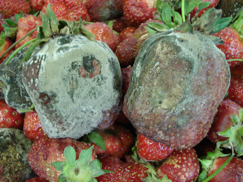 Gray Mold (Botrytis Fruit Rot) Gray mold is often a serious problem during extended cool, wet periods when fruit are sizing and reaching maturity. Symptoms of gray mold are the diagnostic grey, fuzzy growth that will cover entire fruit. Control of gray mold, like the other diseases, begins with recognizing the conditions for its development, its symptoms, and preventative fungicide applications. Start sprays when plants begin to bloom, because 90% of fruit infections occur through the flower, and repeat every 7-10 days. Increase spray intervals during persistent dry periods, but decrease intervals to 5-7 days during very wet periods. Four weekly sprays starting at 5-10% bloom are usually sufficient for season-long control. Tank-mix and rotate fungicides from different FRAC codes to reduce the chances for fungicide resistance development. Fungicide resistance in Botrytis is widely known and documented. Resistance development has been documented in MBC fungicides (FRAC code 1) to benomyl (no longer on the market) and thiophanate-methyl; the DC fungicides (FRAC group 2) with iprodione; the SDHI fungicides (FRAC group 7) with boscalid, fluxapyroxad, and penthiopyrad; the AP fungicides (FRAC group 9) with pyrimethanil and cyprodinil; the strobilurin fungicides (FRAC group 11) with azoxystrobin, trifloxystrobin, and pyraclostrobin; and the Hyd fungicides (FRAC group 17) with fenhexamid. Cross resistance to fungicides within specific FRAC groups has also been widely documented. Most importantly, resistance to multiple FRAC groups has also been widely reported in Botrytis in the US. Recent studies across the southeast have shown that some Botrytis isolates can carry resistance to 2, 3, 4, or 5 different FRAC groups. A study from 2015 examining 2,000 Botrytis isolates collected across the southeast discovered that some isolates carried resistance to 6 or 7 different FRAC groups. As described the authors, this was likely the result of “selection by association” in which resistance was selected by the fungicide applied but also indirectly because the selected isolates were also inherently resistant to fungicides in other FRAC groups. |
How to manage fruit rots and fungicide resistance development
The use of mulch to prevent/reduce soil splashing and keeping fruit from coming into direct contact with the soil surface can be beneficial in conventional production as well as organic production systems where conventional fungicides cannot be used. Long crop rotations and staying away from fields with known history of any of these pathogens is also extremely important, although this may be difficult on farms with U-pick operations where fields need to be close to the market and accessible. Adjusting plant populations to improve air movement and the drying of leaves and fruit within the canopy, and avoiding overhead irrigation are some of the cultural practices growers can do to help reduce losses to fruit rot.
Strawberry growers need to pay careful attention to the efficacy of all high-risk fungicides used during the season. Fields should be scouting regularly, particularly before and after a fungicide application. Remember, due to the specificity of high-risk fungicides, once resistance develops to any one particular fungicide chemistry the likelihood of cross-resistance development increases significantly to other fungicides within the same FRAC group. If loss of efficacy is noticed, growers should discontinue the use of that FRAC group during that growing season. Growers developing season-long fungicide programs for fruit rot control need to use as many different modes-of-action (i.e., different FRAC groups) as possible and limit the use of any single mode of action as much as possible to help mitigate resistance development. This is especially important when growers are applying fungicides with more than one mode of action. Careful attention needs to be made to both fungicide chemistries so that the same mode of action isn’t used during the next application. As a general rule, growers need to use as many different modes of action as possible and to space them out as far apart as possible during the production season.
For more information on the control of anthracnose fruit rot, gray mold, and leather rot in strawberry please see the 2024/2025 Commercial Vegetable Production Recommendations Guide for the mid-Atlantic Region.
Check out the Plant & Pest Advisory Organic Farm Advisory section which contains recommendations grounded in replicated trials and experience. These articles aim to support NJ commercial growers using organic methods.
Cooperating Agencies: Rutgers, The State University of New Jersey, U.S. Department of Agriculture, and Boards of County Commissioners. Rutgers Cooperative Extension, a unit of the Rutgers New Jersey Agricultural Experiment Station, is an equal opportunity program provider and employer.
Rutgers University is an equal access/equal opportunity institution. Individuals with disabilities are encouraged to direct suggestions, comments, or complaints concerning any accessibility issues with Rutgers web sites to: accessibility@rutgers.edu or complete the Report Accessibility Barrier or Provide Feedback Form.
Copyright © Rutgers, The State University of New Jersey, an equal opportunity, affirmative action institution
Copyright © 2025 · Generate Child Theme on Genesis Framework · WordPress · Log in